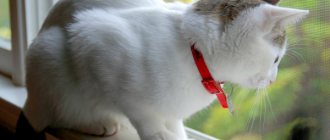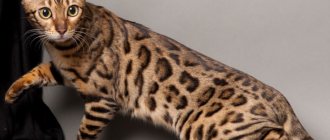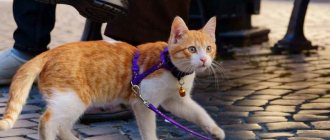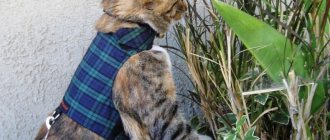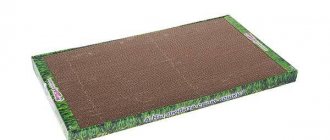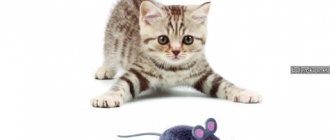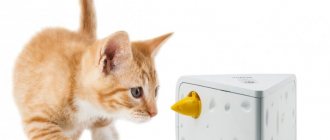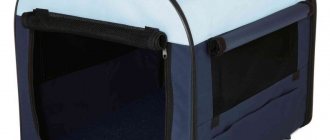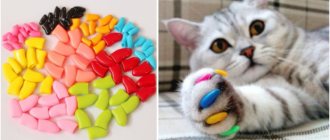A cat harness is a device for safe walks, an original accessory, and sometimes even stylish clothing for your pet. Curious and free-spirited by nature, she loves to explore new areas. But this animal, although predatory, is undoubtedly fragile, it is very easy to frighten, and the first instinct will be to run away and climb higher. It is in such cases that you need a strap so that you don’t have to remove your pet from the tree and at the same time protect it from street dangers.
What is a cat harness
A harness is an analogue of dog leashes adapted for cats, consisting of interlacing straps to completely envelop the body in the area of the shoulder blades. This device allows you to walk with your pets without fear of losing or injuring them. For cat lovers, this is an indispensable item that can be used in the following cases:
- while walking in the park, in the yard or in other crowded places;
- on trips to the veterinarian;
- during trips, transfers or travel;
- to participate in exhibitions and competitions.
But before you go to the store, you should know some of the design, selection and use features of such products.
Why can’t you just go outside with your cat, without a leash?
Once experienced, stress remains in the memory for a long time. If a pet is not accustomed from a young age to loud sounds and unexpected stimuli, it will become confused and panic in a new environment.
The harness will prevent the scared cat from escaping. Allows you to extend the walk once he calms down. It will help to gradually teach you not to be afraid of the street.
Harness design
Externally, the accessory looks like an interweaving of thin straps into which the cat's head and front paws are threaded. At the top at their intersection in the area of the shoulder blades there is a special ring for attaching the leash with a carabiner. This allows you to evenly distribute the load on the belts, avoiding discomfort for the animal. And the girth around the neck and under the paws prevents him from jumping out of them in an attempt to escape.
When choosing a harness model, there are some aspects to consider:
- fasteners and fastenings should be easy to unfasten and adjust, adjusting the device to the parameters of the pet;
- choose a material that is durable, soft and lightweight, preferably natural nylon or cotton, which does not cause discomfort;
- the optimal width of the straps is 10-15 mm, smaller ones will dig into fur and skin, and larger ones will hinder movement;
- To select the appropriate size, you need to insert two fingers between the product and the cat’s back.
Vest
Such equipment somewhat restricts movement; the animal must be trained patiently. But there is a minimal risk that the cat will accidentally jump out. The shape of the jacket serves as additional protection from the cold.
For hairless breeds, this is an ideal option that eliminates chafing from straps. In hot weather, lighter vests made of mesh fabrics are preferable.
A significant disadvantage is that this harness cannot be adjusted in size, it must fit. Otherwise, the cat will feel cramped in it. He can get out of the oversized vest and run away.
Types of cat harnesses
There are many different designs of harnesses, but when grouped together there are four types:
- The figure eight is made in the form of two loops: one smaller to secure the neck, and the other, larger, to encircle the body behind the front legs. It is fastened on the shoulder blades, which makes it easier to use and reduces the cost of the product.
- The "H" type is very similar to the figure eight, having two straps. The main difference is that they are connected on the back with a straight jumper, which resembles the letter “H” when looking at the pet from above. It is suitable for large cats to compensate for the distance between the neck and the line of the back between the shoulder blades.
- The V-shaped also consists of two loops, but they are connected on the chest with an additional strap. This makes the harness look like a "V" when viewed from the front of the animal, or a "Y" when viewed from below.
- A harness-overall is included in the category of clothing, as it consists of a thick vest to which a rein is attached. It is suitable for fragile miniature pets, when there is a high risk of damaging their ribs with a careless jerk. Moreover, the jacket will warm you up during the cold season and protect your wool from dirt or water.
Trixie with reflective stripes is the best option to buy
A comfortable nylon harness for cats with reflective stripes and a leash will not allow your pet to get lost even in the dark. Reflective elements are sewn into the fabric of the product, providing additional safety for your pet.
Product dimensions: 22×42 cm. The width of the strips is 1 cm. The cat leash is included in the kit and is connected to the harness with a reliable carabiner. The product is suitable for teaching cats discipline, visiting veterinary clinics and exhibitions.
- Plus: does not rub the animal's skin.
- Disadvantage: gradual training of the animal is necessary before use.
Price: 426 rub. More details about the product
Make a cat harness with your own hands
The harness can be made at home, without going to pet stores. A hand-made accessory can be made from any material, taking into account all the parameters of the pet and the preferences of the owners. The technique for this is chosen based on one’s own capabilities and imagination. It can be:
- weaving an openwork or dense crocheted harness;
- knitting a warm product with knitting needles;
- joining leather or thick belts with an awl and a “gypsy” needle;
- making a jacket according to patterns with sewing fabric.
Before you start work, you need to take measurements with a centimeter tape:
- the neck circumference should be loose, with an addition of about 0.5-2 cm for allowances;
- covering the sternum behind the front legs in the area of the shoulder blades, so that two fingers can be placed between the belt and the body of the animal;
- the distance along the chest line from the intended collar to the strap behind the paws.
In accordance with these measurements, you can draw a diagram and cut out straps for a simple harness or a pattern for a full-fledged jacket. For this you can use old jeans, genuine leather, nylon, nylon, raincoat fabric. The leash can be attached to the body with a carabiner, a button and a rivet, or it can be sewn on initially. It is also worth stocking up on rings and clasps for fastening the elements of the product to each other. The individual parts should be sewn firmly so that the reins do not break at the most inopportune moment. And when using decorative elements, you need to be careful: they should not add weight, and must be securely fastened so that the pet does not accidentally bite off or swallow one of them.
When not to use a harness
Owners who love their pets can fork out for the most expensive accessory for them, or spend more than one hour creating an exclusive and one-of-a-kind walking device, watching dozens of master classes. But in order not to waste time and money, you should know in which cases the use of a harness is not recommended:
- It is better to walk cats over 10 years old who have not previously been accustomed to a leash without one, in uncrowded places;
- pregnant, unvaccinated or weak pets who have undergone surgery or illness have a high risk of catching the virus from street animals;
- in children whose immunity has not developed, such an experience can worsen their health;
- For an overly timid cat, using a harness will result in considerable stress, and for an aggressive cat, it will also result in unnecessary injuries.
Reminder for walks
Take your pet’s favorite treat and toy with you - this will help relieve stress and make time outside enjoyable.
Don't neglect safety rules. A first aid kit containing hydrogen peroxide and a bandage will allow you to provide first aid in case of a cut or torn claw.
In the warm season, treat your pet with a remedy against ticks and other parasites. They are carriers of dangerous diseases.
Get age-related and preventive vaccinations against rabies and infectious diseases. An unvaccinated animal can contract a fatal disease on the street.
Combs for cats - tips on choosing a model and step-by-step instructions on how to make them yourself. The nuances of using a comb and comb (85 photos and videos)Automatic cat feeder - types, tips for choosing and comparison of the best feeders of 2022 (110 photos and videos)
- How to train a kitten to use a litter box - correctly, quickly and easily train a cat to use a litter box (125 photos)
At low temperatures, from -20 °C. Prolonged exposure to frost can cause frostbite in the ears or tail.
Simple rules will make walking safe for your health.In dry, sunny weather, with temperatures above +25 °C, refrain from active games outside. It is better for hairless and flat-faced breeds to avoid walking in the heat altogether.
Instructions for use
Even though each purchased harness does not have step-by-step instructions for use, some rules can still be highlighted:
- a collar is fixed on the neck, and if it is missing, a smaller strap is put on so that the ring for the rein is on the back;
- the front paws are inserted into the second loop, for which the figure-of-eight straps are first loosened and then tightened back;
- the straps are tightened and checked to ensure that there are no twisted or too tight fastenings, and that the finger fits freely between the cat’s body and the strap;
- immediately before going outside, attach a leash, the ring to which should be located between the shoulder blades.
It is also easy to put on a vest, you need to stick the front paws through the holes, and then fasten it on the chest and fasten the reins. If you follow these instructions, owners will be able to avoid many problems with a walk or trip accompanied by a pet.
Purpose of collars
Collars are purchased in particular for anti-parasitic purposes, as well as in case the animal gets lost or something happens to it. A medallion is attached indicating the cat's name, owner's phone number or address.
Mr. Cat recommends: how to train a cat to wear a harness
It is also important to properly accustom your pet to a harness. The optimal age for this is from 3 months to a year, when his immunity has formed, and everything new is perceived with the curiosity of a discoverer.
To help the kitten get used to the new accessory faster, you can offer it to your baby for play.
For an adult animal, training should begin differently:
- put the harness in his favorite place to give him time to explore and sniff the new object;
- put it on for walks around the house, motivating wearing the new thing with goodies and affection, and gradually letting him get used to the leash;
- adjust the length of the reins in advance to avoid unpleasant incidents on the street;
- For the first exit, choose a quiet place, bring the cat in your arms and let him sit on the ground, coming to his senses.
But if, once outside, the pet does not move, you should not pull it and force it to walk.
Advantages and disadvantages of harnesses
Like any product, a harness has its positive and negative sides. The first include:
- the opportunity to calmly and safely walk your pets in the fresh air, strengthening the immune system;
- simple design and reliable fastenings that do not allow the head to slip out;
- absolute control in public transport or crowded places;
- a large model range allows you to choose the most suitable accessory according to size and taste;
- sales are carried out in almost any pet store, in different price categories.
Among the disadvantages of helmets are:
- negative reaction of cats to restriction of freedom of movement in the first stages;
- the likelihood of poor-quality fastenings, seams and materials, due to which the pet can break free and run away;
- the need to change the accessory during growth, loss or weight gain, choosing the right size.
Cost of harnesses
The price of a harness may vary depending on the materials used in its manufacture, type and design, and brand. There are the following price categories:
- 100-200 rubles - the most budget option, made in a figure-eight or H-shape. These are artificial leather products from GLG, Triol, Lauron, Arkon, nylon from Trixie, Darell, Zoonik, nylon from Gamma, Pet Hobby.
- For 300-400 you can purchase harnesses that have a more complex design and advanced functionality. They are equipped with sliders for adjusting the length of the straps and chrome fittings. They are produced from nylon or leatherette by the same brands, as well as by the companies Camon, Dezzie, Nobby.
- A harness-vest made of soft nylon will cost 400-800. You can purchase such a product from the companies Triol, Ferplast JOGGING, IPTS, Trixie. The cost here depends on the design of the jacket and the fabric used, the material of the fasteners.
- Expensive ones include harnesses made of suede, corduroy, velvet, leather, produced by a well-known brand, or exclusive products with stylish decorative elements.
In general, you should choose harnesses for your pets, taking care of their comfort, as well as ease of assembly. After all, cats are freedom-loving animals, each with their own character, and few of them will agree to wait for a long time while slow owners put on or take off all the equipment. On the other hand, a quality reason will allow them to safely walk on the street, thereby improving the health and even the mood of the pets.
1111
